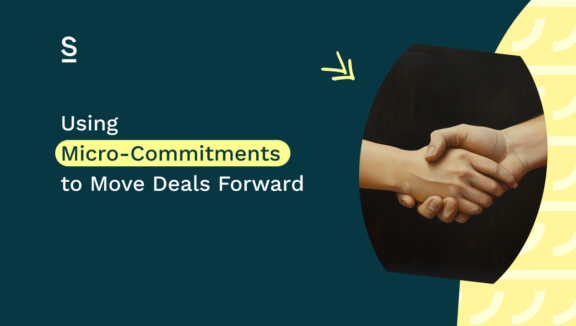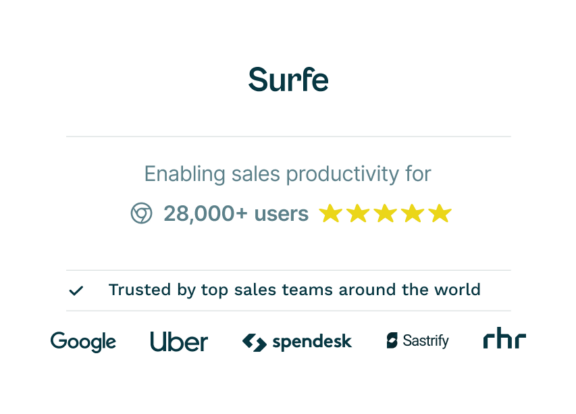Using Micro-Commitments to Move Deals Forward

Ever heard the phrase “Sometimes the smallest step in the right direction ends up being the biggest step of your life”?
We’re not quite sure if the person who coined it was talking about B2B sales – but turns out, it rings pretty true.
A micro-commitment – a small incremental agreement that builds momentum in the sales process – may seem like a tiny step forward at the time, but they’re involved in the progression of almost every deal. Even the really, really big ones. Especially the really, really big ones.
People are more likely to agree to something big if they’ve already agreed to something small. Make use of a micro-commitment, and you’re able to move a deal forward without overwhelming the buyer. Make use of multiple micro-commitments, and you’re edging the deal forward so seamlessly the buyer might not even notice.
Ok, bit of an exaggeration, but you get our point.
Today, we’re going to explain how to use micro-commitments from your buyer to build trust, increase engagement, and drive momentum:
- What Are Micro-Commitments? Understanding Their Role in Sales
- How Micro-Commitments Reduce Buyer Resistance
- Practical Examples of Micro-Commitments in the Sales Process
- Creating a Sense of Momentum: The Cumulative Effect of Micro-Commitments
Ready? Let’s get started.
What Are Micro-Commitments? Understanding Their Role in Sales
When you make a micro-commitment, you’re essentially committing to an action that is so small and so low-risk that it’s almost impossible to say no.
Examples of micro-commitments include:
- Agreeing to a follow-up call
- Downloading a whitepaper
- Scheduling a demo
Let’s take an example. When you first get in touch with a prospect, by email or InMail, you wouldn’t expect them to come back with an ‘OMG, send the contract right now’ would you?
(If you do – can we move to your company please?).
Simply put, that’s just way too much of a risk for them. Even though your product is amazing (obviously) they don’t know you yet. To them, you’re a random person in their inbox. They’re hardly going to sign on the dotted line yet.
Ask them to respond to your email, and that’s a totally different matter. It’s a commitment that’s much easier to make and comparatively has a much smaller risk.
The kicker is by saying yes to this first request, your prospect is making themselves more likely to say yes at a future stage. More on that in a minute.
In fact, 80% of business decision-makers prefer a step-by-step approach to final decisions. This is particularly relevant in the world of B2B, where deals are worth tens or even hundreds of thousands of dollars.
How Micro-Commitments Reduce Buyer Resistance
Micro-commitments are pretty great – we’re sure you get that already. But how exactly do they reduce buyer resistance?
C-suite executives and decision makers – the people you’ll be selling to – are usually resistant to big, sudden decisions, particularly if they involve a third party.
At this level of business, the stakes are often a lot higher and decisions are more complex. The person you’re selling to will need to be extra careful that what they’re selling aligns with the company’s overall strategy – and their forecasts, too.
This is exactly where micro-decisions come in. Break down this big decision into smaller steps, and the risk seems much smaller. You’re not asking for a decision on everything at once – instead, you’re making it into something that’s much more manageable.
We can take note from the 7 principles of persuasion here. One of them is commitment and consistency – the idea that people like to be consistent with how they’ve previously acted. In other words, once they identify as someone who has previously committed to something for you, they’re much more likely to do the same in the future.
Get your buyer to agree to something small, and they’ll be more inclined to do the same. Simple.
Practical Examples of Micro-Commitments in the Sales Process
So, we’ve run through a few individual examples of micro-commitments – but how do you tie them all together throughout the funnel?
Top of the funnel: this could look like signing up for a newsletter or agreeing to a discovery call
Middle of the funnel: now things have moved along a bit, you want your prospect to read a case study you’ve suggested, or agree to a product demo
Bottom of the funnel: decisions here look like committing to a trial period of your product, or letting you know what their budget is.
You’ll notice that this process is pretty much what you’d do to qualify a lead. The best of the best close 30% of sales-qualified leads.
In fact, we can use an example to illustrate our point. Meet Harry. Harry’s a great salesperson. He understands the power of micro-commitments – in fact, he started the conversation with his latest customer by emailing and asking for their thoughts on a piece of original research his business had published.
Once he’d got them to agree it was pretty interesting stuff, he moved on to a discovery call. From there, he sent a few relevant case studies and asked them to read them – nothing more! – before organizing a product demo. This call threw up a few anxieties around price, so he asked for their budget before coming back with a solution that was in-budget. Next thing his customer knew, they were signing on the dotted line.
Give yourself a pat on the back Harry. Job well done.
Strategies for Integrating Micro-Commitments Into Your Sales Process
Next up – how do you actually integrate micro-commitments into your day-to-day?
Ask for small commitments early and often: for example, ask for a reply to your email, your POC to bring a stakeholder to a product demo, or for an example of their biggest business problem.
Make the ask low-risk and clear: simple, actionable language – “Can I send you a quick video demo?” rather than “You MUST watch this 30-minute video I’m about to send you, it’s got literally everything you would to know, ever”.
Leverage automation tools: if all of this sounds like a lot of work, it doesn’t have to be. Asking for a micro-commitment can easily be automated – particularly in the early stages of prospecting. A tool like ActiveCampaign or Omnisend will automate the messaging of emails depending on your lead segmentation – so you could send a different piece of content to different buyer profiles, for example.
Use data: if you’ll allow us to use some data for a sec – 50% of buyers choose the vendor that responds first. Base your micro-ask on buyer intent data – a page they’ve recently used on your website, for example, and you’re able to respond in a speedy, non-invasive way, keeping them interested until the later stages where you can afford to put more time into your response (within reason, of course).
Creating a Sense of Momentum: The Cumulative Effect of Micro-Commitments
Asking for a micro-commitment is a bit like pushing a tiny snowball off the top of a mountain. By the time it gets to the bottom it’s become an avalanche – or at least a really, really big snowball.
Small agreements lead to larger decisions – and once momentum is built, it’ll be easier to close the deal. This is because a gradual process lowers resistance, making it easier for decision-makers to commit to bigger decisions once they’re more invested in the process.
Think back to Harry, and how he started the sales process for a huge deal by asking for an opinion. Now let’s meet Harriet – his opposite, if you will. She’s not a great salesperson and starts a conversation by asking for a demo call. Without the momentum of a few small commitments behind her, Harriet’s email is far more likely to be ignored, or – worse – end up in the ‘marked as spam’ box.
Overcoming Common Obstacles: How to Handle Hesitant Buyers
Your micro-commitments can be the most beautifully orchestrated and carefully asked in the world – but that doesn’t mean that you’ll occasionally run into some hesitation.
If a buyer hesitates to make even a small commitment, we’ve got one word for you. Empathy. It’s easy to get defensive – they won’t even agree to a tiny ask?! – but that’s not going to get you anywhere. Instead, try to listen out for what they’re telling you by hesitating.
Maybe it’s price, maybe they don’t quite understand what pain point your product solves do for them, maybe it’s something else entirely…from here, you can reinforce the value of the commitment by linking it back to their business needs.
To use an extremely basic example – if they’re worried about price, you might mention that the ROI calculator you’re sending them will show that their investment will be well worth it six months or a year down the line.
You could also try reframing the ask – like requesting something smaller or articulating the question differently – to see if that does the job. It might just be a case of giving more detail so they can see just how tiny the ask is, for example.
You could even make a micro-commitment yourself – promising a free consultation or speaking with a current customer, for example – to continue your relationship in a way that promotes reciprocity and commitment. Pretty clever, right?
Remember, being patient and nurturing your prospect is all part of the process. Hesitation is normal. In fact, 80% of sales need multiple follow-ups to close.
Let’s Wrap It Up!
Hey – did we just get you to make a micro-commitment by reading this blog? Maybe 😉
Let’s leave our reasons for writing another day. By now, you should be fully invested in the idea that tiny steps lead to big results. Carefully sprinkle them throughout the funnel, and make sure to ask in a way that’s timely and non-invasive, and you should soon have built enough momentum to carry your prospect through to closing a deal – and beyond.
You can thank us later.

Speaking of micro-commitments…
Fancy giving Surfe a try for free? There’s no catch – promise.
FAQs About Using Micro-Commitments to Move Deals Forward
What Are Micro-Commitments and How Do They Help Move B2B Deals Forward?
A micro-commitment is a small incremental agreement that builds momentum in the sales process. Micro-commitments can move the progress of a B2B deal along by breaking down a big decision (like buying your product) into smaller decisions that have a smaller perceived risk. It’s much easier to get your buyer to agree to something small. From there, you’ve established a relationship based on commitment and consistency: your buyer identifies as someone who makes commitments to you and is therefore far more likely to make another one.
Why Are Micro-Commitments Effective for Overcoming Sales Objections?
Micro-commitments are a great way to overcome sales objections, as it’s more difficult for a buyer to object to something so tiny. If you make a big ask off the bat, like agreeing to a product demo for example, it’s a lot easier to say no to than, say, asking someone to reply to your email.
If your buyer does make an objection, you could reframe the ask to address their concerns and link it back to their business’s needs. Or, you could even make a micro-commitment yourself to encourage them to reciprocate.
What Tactics Can Be Used to Leverage Micro-Commitments in Long Sales Cycles?
Use micro-commitments in your long-term sales strategy by:
- Taking advantage of automation: an email automation tool, for example, will help you make micro-requests at scale without overwhelming your to-do list.
- Asking for small commitments early and often: this will set the tone of your relationship from the get-go.
- Using simple, actionable language: doing so will make the ask low-risk, as your prospects will understand exactly what they’re agreeing to.
- Use data: buyer intent data will help you ask exactly the right question, at exactly the right time. The more personalized a micro-request is, the more likely a prospect is to say yes – because it’s in their best interests to do so.


